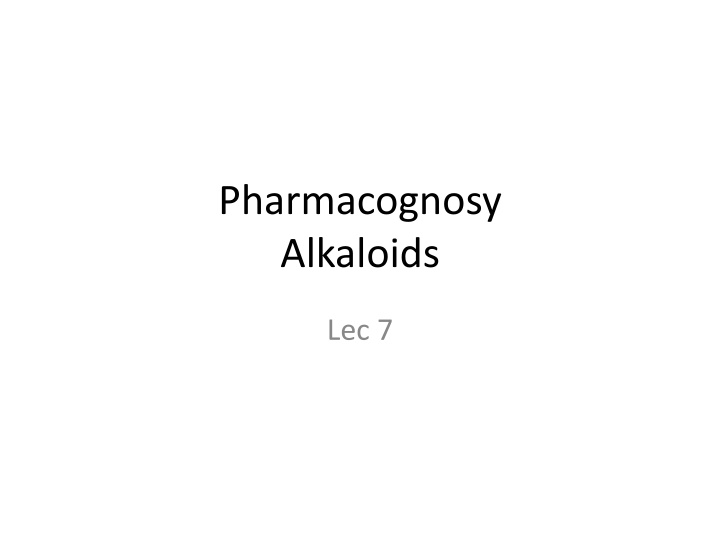
Exploring Alkaloids: Atropine, Henbane, and More
Delve into the world of alkaloids through a study of compounds like atropine, hyoscyamine, and hyosine found in plants such as belladonna, henbane, and datura stramonium. Learn about their properties, historical uses, and pharmacological significance in this fascinating exploration of natural compounds.
Download Presentation

Please find below an Image/Link to download the presentation.
The content on the website is provided AS IS for your information and personal use only. It may not be sold, licensed, or shared on other websites without obtaining consent from the author. If you encounter any issues during the download, it is possible that the publisher has removed the file from their server.
You are allowed to download the files provided on this website for personal or commercial use, subject to the condition that they are used lawfully. All files are the property of their respective owners.
The content on the website is provided AS IS for your information and personal use only. It may not be sold, licensed, or shared on other websites without obtaining consent from the author.
E N D
Presentation Transcript
Pharmacognosy Alkaloids Lec 7
Tropanealkaloids Atropine, hyoscyamine and hyosine (scopalamine) Atropine (racemic alkaloid), hyosyamine L- form, scopalamine is epoxy-hyosyamine
Belladonna, Henbane and Thornapple (-)-Hyoscyamine: from Atropa belladonna and Hyoscyamus niger. Atropine: the racemic mixture ( ) of hyoscyamine, found in A. belladonna Formerly used as a smooth muscle relaxant now used in eye examinations to open the pupil (=mydriatic) and in acute arrythmias Hyoscine (scopolamine): from Datura stramonium etc. used to prevent travel sickness and to dry up nasal secretions before anaesthesia All are anti-cholinergic (anti-muscarinic)
Follow the label Feeding study
Datura stramonium Thornapple
Deadly nightshade Atropa belladonna The name Atropa comes from the ancient Greek Fate, who in mythology cut the thread of life. belladonna comes from the Italian for beautiful lady, and refers to the use of the juice of the berries of this is plant by ladies in the 16th century to dilate the pupils of the eye, considered an attractive feature
Atropine Atropine is used as to dilate the pupil of the eye. It degrades slowly, typically wearing off in 2 to 3 days, so tropicamide (a synthetic shorter-acting cholinergic antagonist) is generally preferred as a mydriatic. The effects of atropine can last up to two weeks. Right eye half an hour after administration of tropicamide. Note the red retina. Atropine induces mydriasis by blocking contraction of the circular pupillary sphincter muscle, which is normally stimulated by acetylcholine release, thereby allowing the radial pupillary dilator muscle to contract and dilate the pupil. Atropine is contraindicated in patients predisposed to narrow angle glaucoma. Dilation of the pupil
Henbane Hyoscyamus niger The name henbane came from the Anglo- Saxon hennbana = "killer of hens". It was traditionally used in German pilsner beers as a flavouring, until the Bavarian Purity Law was passed in 1516 and outlawed the use of Henbane and allowed only the use of hops Henbane was also known to have been used as an anaesthetic in the first Arab hospitals
Tropane alkaloids 2: Cocaine From Coca leaves - a shrub, Erythroxylum coca, found only at high altitudes, in the Andes (Peru, Bolivia, and Columbia) Coca (still) used by locals to ease altitude sickness and reduce hunger and fatigue Cocaine is a CNS stimulant widely used illicitly, as the salt, the free base and now as crack (made with sodium bicarbonate) cocaine rarely used medicinally now, and only as a local anaesthetic in eye surgery
Coca: Erythroxylum coca CloseUpRainOK400 Cocaine occurs in the leaf as the free base but this is not very stable so it is extracted using a dilute acid, to form the salt and this is the form used pharmaceutically (e.g. cocaine hydrochloride) It may later be converted back into the free base form because absorption is much faster for non-ionic (i.e. lipophilic) substances
Cocaine Prepared semisynthetically from of ecgonine Adrenergic stimulant, local ansthetic cause addiction
Alkaloid chemistry: crack cocaine Base (alkaloid) + acid alkaloid salt + water e.g. Morphine + sulphuric acid morphine sulphate + water Cocaine base + HCl cocaine HCl + water But a weak acid or base is displaced by a stronger one .. so Cocaine HCl + stronger alkali (e.g. NaHCO3) cocaine base (crack) + salts + water To make crack, powder cocaine the salt is dissolved in a mixture of water and either ammonia or sodium bicarbonate (baking soda) added. The mixture is boiled to separate out the solid, and then it's cooled. The solid is then dried and cut up into small nuggets, or "rocks." Although crack cocaine is a form of non-ionic cocaine, because production doesn't require the use of flammable solvents, it is safer to make than freebase
Alkaloid chemistry: making crack (base) cocaine from the salt Step 1 (left): Dissolving powder cocaine in hot water Step 2 (right): Adding sodium bicarbonate to the mixture Step 3 (left): Boiling the solution to separate out the solids Step 4 (right): Cooling the separated mixture Step 5: Filtering the cooled mixture cocaine crack-15
Than you for listining THE END















